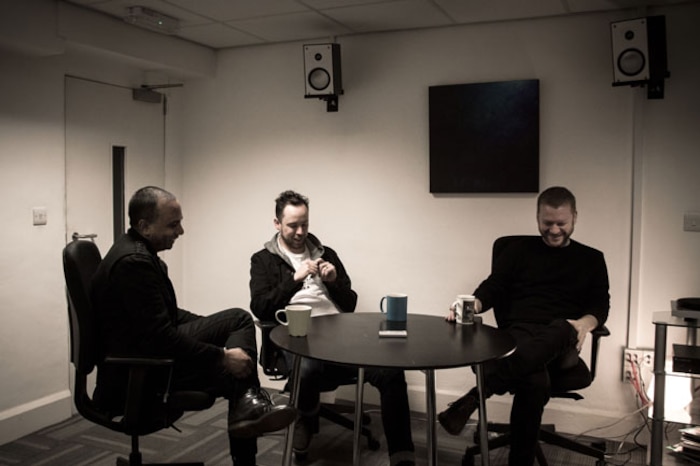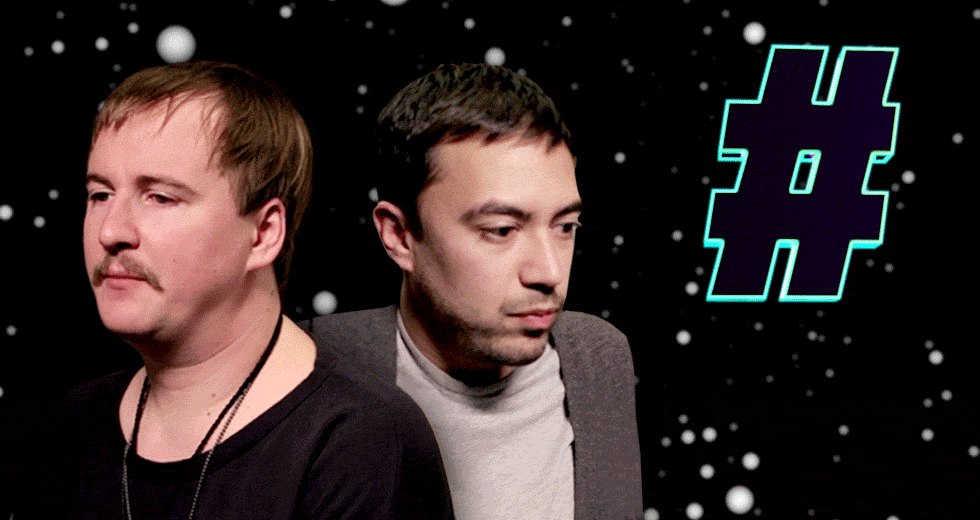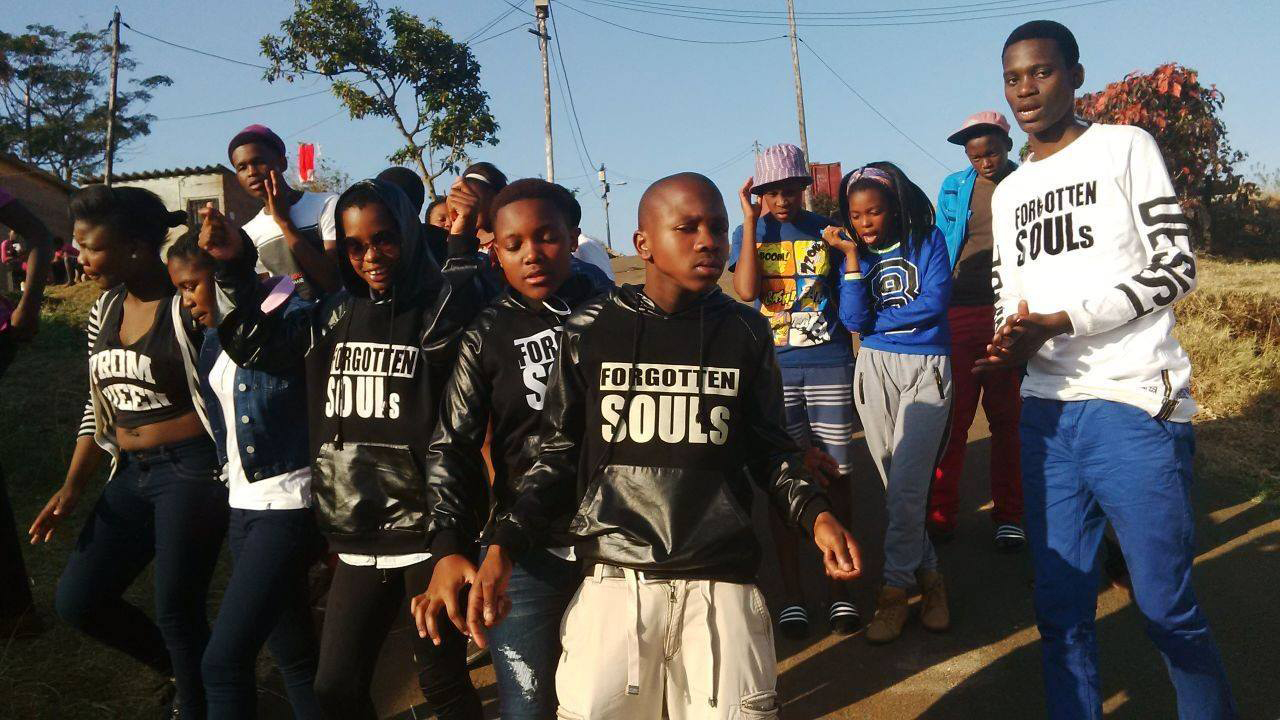Bristol Subtext Roundtable: Emptyset’s James Ginzburg, Paul Jebanasam and Roly Porter
For a while mid-to-late last decade, Bristol’s blossoming dubstep scene brought a cluster of disparate musical minds into temporary alignment: producers inspired variously by grime, R&B, dub, reggae, techno, jungle and industrial musics, all united by sub-bass, sound system weight and a shared tempo range. In parallel with the genre’s wider dissolution, from 2009 to 2010 the city’s scene began to unravel and fragment, with groups of producers separating off onto their own tangents. The Subtext label gathers the work of one such group. Since 2011 it’s issued a series of recordings by James Ginzburg and Paul Purgas (AKA Emptyset), Red Bull Music Academy alumni Paul Jebanasam and former Vex’d man Roly Porter, adding up to a thematically coherent, concept-led and exploratory body of work.
With all three having moved purposefully away from dance music in recent years – but not, crucially, from a love of massive sound systems and the experience of music as a full-body force – the label’s output to date has documented the establishment of a distinct shared musical language. It’s centred around space, physicality and abrasion. And, also, it’s increasingly concerned with the interaction between sound and visual art. Given that the label’s key figures have released acclaimed albums this year, we figured the time was right to travel to Multiverse in Bristol to speak to Ginzburg, Porter and Jebanasam about the past, present and future of the label and the evolution of their own personal projects.
I wanted to start by asking why you, James, chose to reboot Subtext after so long, having originally released the early Vex’d 12-inches via the label nearly a decade ago now.
James Ginzburg
We started the label originally at the end of 2004, it pre-dated Tectonic, and we thought that was going to be the dubstep label we ran with. We put out the first two Vex’d 12-inches, Pop Pop and Lion, and because we felt so passionate about those releases we kind of needed something to follow up from them that we felt was as good. But in the meantime Rob Pinch and I started Tectonic, as another label to put out the stuff that was passing through our hands, until the point that we could find something else we wanted to put out on Subtext. But Tectonic took on a life of its own. I stepped out of having anything to do with A&Ring – which is also coincidentally when the label started to do really well under Rob’s wise guidance! – and then Subtext kind of sat dormant.
Hearing the demos for Roly Porter’s Aftertime was one of the first times in four or five years that I’d heard music I found really exciting.
Vex’d had broken up in 2008. I’d never really known Roly that well at the time, I was more in touch with Jamie [Teasdale, the other half of Vex’d; now Kuedo], but Roly moved to Bristol in maybe 2010. He wasn’t really making music for a few years, but at some point he came over with an album he’d made and played it to me in the studio here. I basically begged him to let us release it, and he would only let us release it if, a) we rebooted Subtext, and b) Emptyset put out Demiurge as the first release to reboot it, because that was sort of floating in the ether and we weren’t really sure what to do with it. So we put Demiurge out and followed up with Aftertime not so long afterwards.
Hearing the demos for Aftertime was one of the first times in four or five years that I’d heard music I found really exciting. So it felt like good timing, particularly along with the material that Paul Jebanasam was making as well – as with all of us previously, he’d been doing more dance-oriented projects, [but now was] working more in looking at the crossover between minimal classical music and experimental music. It was one of those rare moments where things just coalesce in a really fortuitous way. It created a context for a lot of ideas that were circulating, and just seemed a very clear road forward.
To what extent do you see Subtext as a home base? Is there a collective aspect to what you do?
James Ginzburg
The vision between what we’re doing for Subtext and what we’ve done for Raster Noton is a very clear distinction. Subtext was allowing us to explore a strange thread of quite elaborate projects that involved something beyond just studio practice [like the site specific recordings gathered on Medium and Material]. The output for Raster Noton just ended up becoming an extension of our studio explorations, whereas I guess the gestures within Subtext tend more towards the grandiose and poetic. [laughs] Which I think goes for everyone really. Maybe not grandiose as in delusions of grandeur, but more a lack of self-consciousness around thinking of your projects as beyond being just 12-inch or album releases.
Because we’re not having to take these ideas to someone that’s running a label, we can take it and go all the way with it.
After however many years of being involved in music, the possibility that a music project can be more of an elaborate gesture is really exciting and inspiring. As Roly has said, it’s total freedom, but also involves a kind of mutual editorial process. It’s one of the few projects I’ve been involved in, in terms of labels, which has ended up being a functional collective. It’s probably only functional because I think we understand each other’s work, so interaction and feedback tend to enhance the process rather than creating weird conflicts.
Is creative feedback between you an ongoing process while you’re working on music, or more something that happens when projects are ostensibly finished?
Roly Porter
With the Life Cycle project I’d pretty much finished it, and these two were the only people I played it to before it came out. But with other things there’s definitely a lot more back and forth.
James Ginzburg
There are also perpetual pub conversations and late night kitchen conversations. Without necessarily saying “Here’s a piece or an idea, what do you think?,” the ideas that come out of those conversations tend to inspire and send your creative processes in certain directions they wouldn’t go otherwise.
Paul Jebanasam
I reckon that’s where the grandiosity, if you could call it that, might come from. In any group of friends’ conversations there’s a point where they go, “What would happen if we made that film instead?,” or “What would happen if we were in charge of the world?” So I’ve had lots of discussions with Roly about ideas to do with science and his take on that – and because we’re not having to take those ideas to someone that’s running a label, we can take an idea and go all the way with it. There’s no sense that “that’s too crazy to do on a record,” which in a less conversational space might be the case.
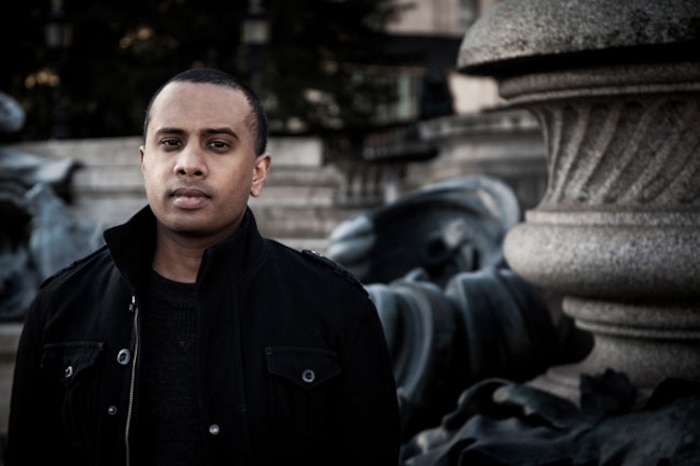
You all started off in the dance music world, but have shifted into other spaces in recent years.
Roly Porter
Historically we’ve all had similar responses to various genres in electronic music. We’ve all been involved with music for quite a long time, and seen it change for each of us personally. There’s a shared... maturity sounds a bit bigheaded, but we’ve each come through a similar journey in our relationships with electronic music, and ended up in a place where we’ve found a way of being comfortable with staying in electronic music and still generating new forms of interest, purely to fill a gap in our own lives.
James Ginzburg
There was that commonality between starting out in a very overt, if to a degree experimental, dancefloor context, and through our own avenues each feeling that our interest in that had waned. Perhaps not so much in the context of the act of listening to very loud, bass-oriented music on a sound system, but in something about the situation or the culture and the format.
You were all involved in the community surrounding dubstep during the time it was kicking off in Bristol. What was interesting about it to you at the time?
James Ginzburg
I remember going to FWD>> for the first time with Pinch in 2004 or so, and we were all massively inspired and excited, so we started Subtext and started working with Vex’d. When things started kicking off in Bristol it was very much an extension of what Pinch was doing with his Subloaded and Context nights. I was working on other projects outside the dubstep context [too], so I never felt totally entrenched in that particular scene.
I entertained all these fantasies, but then I got here, and it was cool and loud, but I was standing around going, “This is basically just another club.”
Roly Porter
I lived in London at that time so I didn’t actually connect that heavily with the Bristol scene. In fact, it was always nice coming down and seeing the difference. Not really in music – it was a similar sound – but going to [Easton club] the Black Swan. For someone who lived in London and was going to clubs at the time, it was just amazing to go there – they had a massive fire in the garden, it was a kind of party scene I hadn’t realised was still going on, it felt like old free parties but it was in a club. Which was really refreshing. Most clubs in London double as a house club on a Saturday night, so you’re in a room with mirrors and red velvet everywhere, and then you go down to Bristol and you’re in a kind of barn [laughs] with a massive sound system. But the exciting thing about it was the variety in the music – at the time there were just so many variations in style and rhythmic structure. It was just a really exciting and varied time in music, which very quickly came to an end.
Paul Jebanasam
In 2007, I actually got booked for a festival over here [as Moving Ninja]. That was my first introduction to actually experiencing this music outside of Sydney [Australia]; there was a scene in Sydney but it was small and the sound system thing hadn’t really caught on yet. In Bristol it was a lot louder, but strangely enough it was all kind of disappointing, in my head it was something else. Dance music had run out of ideas for me, in a sense, when dubstep came along, but dubstep was a different beat structure and you could kind of technically do anything – you could have a drone for four minutes and a beat and it’d be OK.
Because there was a lack of it happening in Sydney, I could kind of invent a version of this hyper-futuristic rave scenario that was somehow cyberpunk and mystical and underground. I entertained all these fantasies, but then I got here, and it was cool and loud, but I was standing around going, “This is basically just another club.” It was really fun, but it wasn’t what I’d built it up to be. I was in my early twenties as well, so I just had a version of this bastion, this last place in dance music where ideas were happening, that was extremely progressive. There was a period where it was like how Kode9 put it – “as long as you’ve got sub you can do anything.” But that seemed to have almost gone by the time I got here [and halfstep had taken over]. Which was fine, I don’t think I came here to make dubstep. I felt like I’d finished that thing by that point.
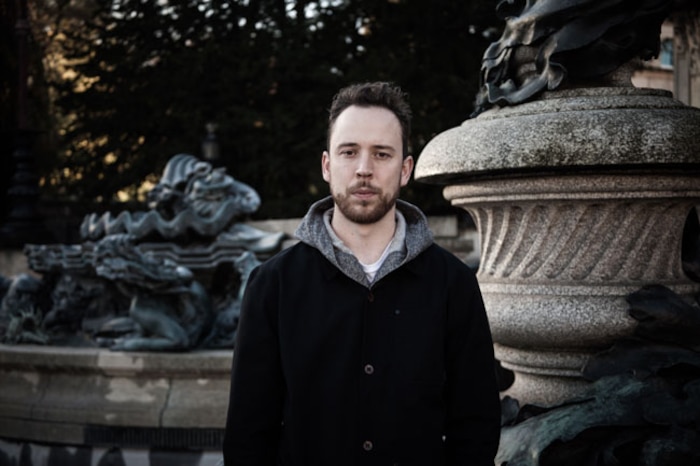
What do you think you’ve brought through from that time to what you’re doing now?
Roly Porter
It sounds ridiculous, but I feel like I’ve managed, for me, to distill all the elements that I enjoyed from the music I wrote into one form, and eradicated everything I didn’t enjoy. Which isn’t to say that I’ve managed to distil the perfect form of electronic music! For me, personally, everything I always thought I did well and enjoyed listening to and producing is all I’ve got left now, and everything else has gone. I like beats, I used to love raving and dancing, but I’ve never particularly enjoyed that side of production. I’ve taken from years of jungle and dub the delayed, weirdly distorted sound effects, the soundscape things. And when I listen and work on my music now, I’m still hearing those elements from all those genres, but just the bits I liked. So it’s a personal refinement, a distillation, of 25 years of British electronic music. It’s great, I have my own personal half an hour of good bits.
Not feeling the need to enter into, or have a conversation with, the world of dance music meant that it was a freedom to do anything.
The answer is probably different for each of you, but I’d be interested to hear about the thought processes behind your shifts from club music to a broader approach.
Paul Jebanasam
For me with dance music, it got to a point where I couldn’t actually see how a piece of music could move in certain ways [due to club music’s fairly rigid parameters]. For me there was a problem with rhythmic music, and I haven’t still been able to go back to it. When I listen to the Emptyset music, in terms of materials and structure, it’s actually solved the problem. It’s articulated exactly what I wanted rhythms to do, but I’ve never been able to do it myself: a sense of motion, and structures that are moving without a particular goal that you could follow or predict, which creates a strange mode of listening. I was always trying to experiment with that, but I got stuck. They had to put a lot of time and work into actually getting there – half process R&D, and half just doing the graft, going in and making stuff and making stuff.
James Ginzburg
I got really exhausted by the feeling of perpetually competing within dance music. You always have that anxiety, even when you have a big record that’s just come out, you know that the end was nigh. [laughs] Unless you have the next big tune ready to come out in six months, there’s a huge amount of angst over where your career is going. Simultaneously with that, there was a sense that I couldn’t listen to dance music without feeling like it was entirely interchangeable. There was nothing, in the act of me going to the studio and making anything, that felt like an original or even a personal gesture. That also manifested itself in touring and DJing, finding myself onstage and feeling totally disconnected, feeling that I ran the risk of it becoming a slightly fraudulent act.
So at that point I needed to totally reconsider not only what I was doing musically but also in general, and I’d even entertained the idea of giving up music. It was just good timing that, around that time, me and Paul Purgas had given up on trying to make dance music and started looking at other structures. Not feeling the need to enter into, or have a conversation with, the world of dance music meant that it was a really relaxing freedom to do anything, for the first time in my musical career. We really had no sense that anyone would ever listen to anything we’re doing. We were doing a pointless gesture for ourselves, and to get anything done we just made up deadlines.
Something that unites all your music now is an awareness of spatiality, certainly when you experience it at high volume. James, you’ve done site specific work with Emptyset, but you’ve done shows in churches which work with the resonance of the space, for example. To what extent is it important to you to bring your music out of the studio or small speakers, and have it interact with physical space?
James Ginzburg
You can’t help, when you play gigs, but have some sense that there’s feedback between the act of creation and performance. Obviously with the site specific projects, which were specifically about working with space, it’s incredibly relevant. But outside of that, you’re creating a universe in the studio, and that either works in other environments or it doesn’t. At Berlin Atonal festival, which we did a label night in over the summer, the actual space is a vast former power plant, it’s bigger than a cathedral. A lot of the stuff that Paul [Jebanasam] was playing was inspired by a lineage of choral music or organ music for churches, and these pieces sounded incredible in that space, where a lot of the music on other nights that was perhaps more ornamented or detailed was kind of lost in that space. It wasn’t like Paul had composed specifically for that space, but because he was composing with a certain tradition in mind, it translated.
Roly Porter
The output of Subtext is one of the first things I’ve ever been involved in that doesn’t demand a sound system environment. I love loud music, that’s how I’d choose to listen to it, but I think most of the output on the label so far translates really well for home listening. And that’s exciting – it’s nice to know that you’re not relying on having to absolutely smash it out on a sound system to make it work – and a new challenge for me. But it’s always good to turn it up. [laughs]
What’s struck me when I’ve seen you guys live is that there seems to have been a lot of care taken around bringing visual and audio aspects into strong alignment. I’d like to hear your feelings around wanting to take what you do beyond just sound, into more a multi-disciplinary approach.
Roly Porter
Any way of increasing the immersive nature of artistic experience. The audio-visual thing works really well with this type of music, but it does require a lot more composition. In dance music you can have a fast-paced visual element that’s basically interchangeable with different sets, so you can have the same video running the whole night and basically no-one’s going to notice. But that would be entirely inappropriate for my current live set for example, which does require a more composed, joint effort between video and audio. My choice is either to do that or play in complete darkness – to make sure that nothing detracts from my part of it, which is the audio, and offer the audience the opportunity to become immersed in that.
James Ginzburg
With Emptyset there’s been a massive feedback loop between what we’ve been doing musically and now what we do visually. Our approaches to visual content have moved beyond doing the musical performance-plus-visual show collaboration with Joanie LeMercier – a really good friend whose work we really admire – into something that’s integrated and based on processes we’ve developed ourselves, which are a mirror of the processes we use to make sounds. So you create an experience which is a whole – a sum total, in the same way that in a film you see the image of the person talking and you hear the sound of the words, there’s no [distance between the two]. When I first heard dance music it evoked the sense of other. I had no idea how it was being made, and it was part of these new experiences I was having that were overwhelming and life changing, but at some point that doesn’t happen [anymore]. So it’s like, how do you explore a world in such a way that evokes a sense of other, of what’s beyond the periphery, and what’s beyond your imagination? That’s the perpetual pursuit that’s maybe common to what we’re doing. We’re not trying to make good versions of things we’ve heard before. The excitement lies in finding something just beyond the horizon.
Paul Jebanasam
What I really like about the Emptyset process [of producing both sonic and visual output] is that there’s something very literal about it – or not even literal, the material itself is raw information, and electricity, and the way those things interact against thresholds. There’s something that [reminds me of] icon painting. Really early icon painting wasn’t seen as being made by an artist – this was pre the Renaissance idea of “oh this guy’s an artist and he’s been commissioned to do this” – it was viewed as if some divine moment had happened and created this thing, there’s no artist involved in it. There’s something strange about that kind of stuff. It’s obviously people that make it, but it’s almost like a trace or a record of a weird material process – it stops being about machinery, and it’s just machinery. In the live show, when you’re watching these crazy visuals, it’s like, “I’m looking at voltage right now,” as opposed to trying to invoke some other idea.
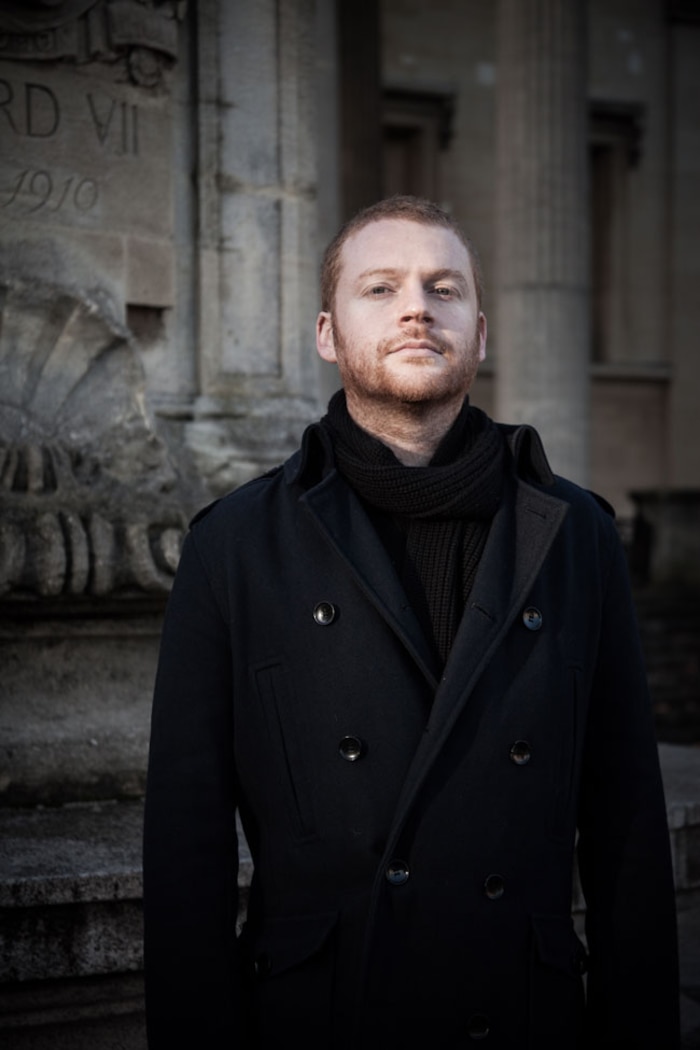
James, when I spoke to you last year, you described Emptyset’s progression as a series of steps – going from working on the grid, to gradually taking music progressively off the grid, and exploring elements of causality. Recur feels like both a refinement and an expansion of the aesthetic you’ve been working towards for quite some time. What’s underpinning this one, in terms of ideas and processes?
James Ginzburg
From the point of view of my literary interests and my interest in narrative and narrative structures, I’m very interested in the relationship between the idea of historical time – linear time, linear causality – and the idea of mythic time, atemporal time. Trying to relate that back to musical structures, we became interested in playing with the idea of whether we could shift from horizontal causality – where this happens and then that happens, in an orderly and repetitive way – to look at more interesting structures. Could there be other rules that could govern the causality of events? For example, I was thinking of things like the emergence of a universe, or Hoberman spheres, those toys that are like a big polyhedron that you can collapse, but even after they’ve been collapsed they’re still the same object.
I would lose myself for worrying amounts of time staring at the small waves coming off the ocean – this pure, transcendent aesthetic experience.
Relating that to music, you have bars repeated – let’s say it’s 4/4, at a particular tempo – and you can imagine that as a particular geometric structure, let’s call it a square. So you’re going “square-square-square-square-square.” But each one of those objects is basically the same object structurally, so you replace the bar with the idea of the Hoberman sphere – something that’s always the same thing effectively, but has so many different modalities. What would it be like for that structure to express itself in different ways? What rules govern the emergence of a universe from nothingness? There’s a kind of chaotic rule set that determines that.
We did play around with algorithmic approaches to try and generate things. But you get to the point where you ask yourself, is intuition actually a better representation of a kind of ordered randomness, than the contrivance of setting up an algorithm to create actual randomness? I was living on an island earlier in the year, and I would lose myself for worrying amounts of time staring at the small waves coming off the ocean – this pure, transcendent aesthetic experience. It’s a rhythmic event, it has a certain sonorous quality to it. You can’t say it’s a machine, but there’s something kind of machinic or inhuman about it – something that’s essentially other, something generated from a hugely complex set of interactions. But because it’s not got this machinic contrivance, it just becomes a perfect kind of music. It’s the same thing with a thunderstorm or a gale, the musicality of those situations... [all laugh] Not to get too cosmic, but it’s from the same complex interactions that your mind is generated, so there’s a shared language.
We set the sequencer to 10,000 BPM so there’s no lines, and then you just move the events and rhythms to where they feel right.
Going back to music, you’re trying to create the impression not of something human, but something other. We don’t want you to listen to the music and feel like “Oh, I can hear his hand turning the knob.“ You want the situation to be non-referential in that sense. You’re always trying to evoke the essence of something with the tools that are available, and sometimes it takes a bit of poetic license to do that. So for a lot of things on Recur we set the sequencer to 10,000 BPM so there’s no lines, and then you just move the events and rhythms to where they feel right, and if you feel things are repeating too much you break up the repetition. I’ve found it really interesting, particularly coming from writing music with such fixed rhythmic structures, how far you can push rhythms away from being structured in the way you’re conventionally used to, and they still feel... erm... is there a better word than funky? [all laugh]
On the subject of cosmic narratives, Roly, your new album is both cosmic and has a really strong narrative to it. Did you go into it wanting to create something with a defined arc?
Roly Porter
The defined arc is the point, really. The fact that it’s a massive scale of subject matter is kind of beside the point. I wanted to write music starting with a conceptual outline as opposed to starting with studio experimentation, because that’s how I’ve always done it – you just sit around making bass, and something comes out of it. The star works really well from that point of view because it has a life cycle, and it’s easy to define that in the five chapters I chose. I just wanted something that was a framework around which I could challenge myself to fit music, as opposed to the other way around. So that’s where it comes from. Not that I wrote some music and thought, “You know what, this is on such a cosmic scale, this is so grand and so immense, that there’s only one title I could possibly use.” [laughs] I’m sure that’s what people think, and I apologise for that, it was genuinely the other way around – what subject am I interested in and love that has a defined narrative I can attempt to score?
Paul, your album Rites alludes to ideas of religion. How did it come together, and what ideas underpin it?
Paul Jebanasam
It came together over quite a long period. It was to do with an interest in the role that religious music and religious art practices played. It’s not trying to regain a grandeur, or place for music to have that kind of profundity to it; it’s more that what I liked about scenes and writings from religion is how otherworldly they were. Especially in altarpiece paintings – I started collecting pictures of altarpieces, which would tell a very large story, but it would all be happening within the same landscape, all at the same time, you would have a saga represented in one picture. They seem to take place in non-linear time, and some of these stories happen on a really vast scale.
I wanted to have this very threatening [sound] world, but having a very human, humble moment inside it.
So it was taking that as the jumping off point, and designing something that has that kind of form to it, but working out how to get across some of these ideas in a [piece of music] that just goes from left to right. There’s a particular piece called “Für Alina” by Arvo Pärt; it’s so simple, it reduces down to the smallest moment in music, but it seems like it’s at the centre of this vast and violent world. It has its resonance and poignancy and purpose in the storm of everything else – it’s a moment of quiet – and when I looked at especially altar paintings, they had that sense to them. This is why I wanted to have this very threatening [sound] world, but having a very human, humble moment inside it. Those kinds of ideas, the impressions that certain stories and paintings give across, and going “How does that work in musical form?”
What are your current and future plans for the label?
James Ginzburg
We’ve taken on one other person, Eric Holm, he’s an old friend and he’s been making music for a long time and finally gotten to the point where he was happy with the material and we were really happy with it, and again he’s very much been part of a lot of the conversations we’ve been having. He is doing the next album. Myself, Paul Purgas and Eric were up on an island above the Arctic Circle in Norway, working on a film. We went walking in the middle of the night into this vast and snowy wilderness. It’s a weird place because there’s a couple of CIA listening stations on the island, and they’re connected to the villages through telegraph poles with wires on top. Eric’s really fastidious about always carrying around a field recorder and contact mics, so at one point he just stopped in the middle of the night and contact mic’d this telegraph pole, which made the most incredible sounds, really unexpected.
Eric Holm spent the next months constructing an album out of this contact mic’d telegraph pole, and he somehow created the most original dance music I’ve heard.
He spent the next months constructing an album out of this contact mic’d telegraph pole, and he somehow created the most original dance music I’ve heard. It’s not really dance music, but it’s almost more dance music than what [Emptyset’s] doing. It’s almost as if someone had never heard of dance music, and then using this recording of a telegraph pole it’s like, “You’ve kind of made techno” – but with this peculiar sound palette, it feels very otherworldly. Emptyset’s more focusing on art production at the moment. We’ve got a few projects based around translating some of the processes we’ve been developing into creating physical objects, and maybe a more elaborate performance which isn’t based on the ideas within our albums or Medium or Material.
Do you have any vision for where you’d like Subtext to develop, ultimately?
James Ginzburg
It would be good if the internal coherency of Subtext developed to the extent that we were doing more group shows, and bringing in some of the other things we’re working on, whether those are audiovisual presentations or more object and print-based exhibitions. In terms of the projects we’re releasing and producing, that they would be furthering the conversation we’ve already started, and also opening up new possibilities we’ve touched on but haven’t developed completely. Which is a really elaborate way of saying nothing. [grins]
Roly Porter
Well, this year we’ve put out an Emptyset record, a Roly Porter and a Paul Jebanasam record. “What’s next?” Hmm, well, probably another Emptyset record, Roly Porter record and Paul Jebanasam record. [all laugh]
Header image © </em><a href="https://twitter.com/tapeecho"><em>Alex Digard</em></a>
